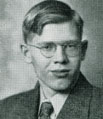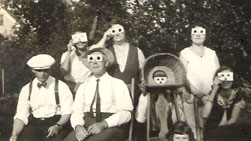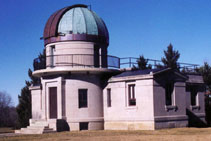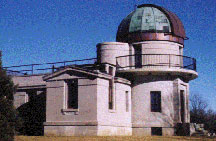 |
North
High Wall of Honor
Dr. Hugh Mitchell Johnson
Class of January, 1941
Astronomer |
 |
 |
 |
 |
Hugh graduated in the North High
January, 1941 class. While he was attending North High, he lived at
1118 West 26th Street, Des Moines, IA.
While living there, he began to reach for the stars. |
 |
|
What
provided the impetus and inspiration for a young man to achieve such extraordinary
levels of success on his ascent up the ladder toward the stars and the astronomical
world? The total eclipse of the moon on July 15-16, 1935. Intrigued by this
occurrence and possessing the attributes of being extraordinarily endowed
as a self-starter, Hugh, at the age of 12, made frequent visitations to
the Highland Park Library and the Downtown Des Moines Main Library to encourage
and research his interest. This pursuit included observing an ad in an astronomy
magazine which motivated Hugh to write a gentleman in Minnesota who was
able to provide instructions on grinding telescopic mirrors. Hugh did just
that in 1935, 1936, and 1937. He built three telescopes. His first two telescopes
were smaller than his third eight-inch instrument. Later helpful assistance
came from Drake professors who permitted access to pertinent astronomy journals/material,
as well as visitations to the Drake Municipal Observatory. Hugh writes that
his observations reported in the document entitled "North Temperate
Belt Markings on Jupiter in 1940-41" (linked below) were made while
he was 17 years old and a senior at North High. The eight-inch reflecting
telescope was one he constructed himself in 1938. (as a point of reference,
the telescope at the Drake University Observatory is an 8-1/2 inch refractive
instrument.) The analysis and writing were done soon after graduation in
January, 1941 during his first job in Des Moines, the full-time job paying
$12/week. He soon thereafter moved to Rochester, NY in order to earn about
three times that rate and to begin saving for his college education.
Even now, after the passage of over 69 years with nationally and internationally
authored/acclaimed publications, Hugh reports that his 1940-41 effort as
a teenager was a well-done piece of work in astronomy.
Read the work of this 17-year-old North High student!
September 7, 1941: North
Temperate Belt Markings on Jupiter in 1940-41
by Hugh M. Johnson. Reprinted from the Journal of the Royal Astronomical
Society of Canada, Volume XXXV, 1941. Online publication permission
personally granted by Dr. Hugh M. Johnson; 03/23/10.
November 1, 1986:
The Orbit and Properties of the HD 149162 System by Hugh M. Johnson,
Lockheed Missiles and Space Company, Palo Alto, CA.
Online publication permission personally granted by Dr. Hugh M. Johnson;
03/23/10.
May 1, 1987: Low-Energy
X-Ray Observations of the WOLF 630 System by Hugh M. Johnson, Lockheed
Missiles and Space Company, Palo Alto, CA. Online
publication permission personally granted by Dr. Hugh M. Johnson; 03/23/10.
...and many more. |
 |
 |
 |
Hugh Johnson
was 12 when the solar eclipse occurred on July 15, 1935. The photo
above illustrates the interest of families during this 1935 event.
|
 |
 |
| Science Hall
at Drake University was built in 1893 and was known as Alumni Hall,
Science Hall, and finally Sage Hall. The observation tower held an
8 1/2 inch refractive telescope donated by General Francis Marion
Drake. As the tower aged and industrial smoke began to block views
of the sky, the telescope was moved to the Drake Municipal Observatory
in Waveland Park. Shown is a current version of an 8-inch telescope. |
|
| Hugh Mitchell Johnson |
 |
| Year |
x |
Rank/Event |
x |
Status |
 |
| June, 1941 |
x |
Graduation |
x |
North High School |
| 1941 |
x |
Moved to
Rochester, NY |
x |
Began working to save money for college.
|
| August, 1945 |
x |
Drafted; AUS* |
x |
While working in Rochester,
NY.
AUS* was a special designation then used for Army of the United States
for those who were drafted, as opposed to those who enlisted. |
| September 5, 1945 |
x |
Drafted |
x |
Enlistment for the duration of the War
or other emergency, plus six months, subject to the discretion of
the President or otherwise according to law |
| date |
x |
Basic Training |
x |
Sheppard Field, TX;
(Army Air Corps Training Center) |
| date |
x |
Training |
x |
Fort Dix, NJ |
| date |
x |
Training |
x |
Langley Field, VA |
| date |
x |
Training |
x |
Trained as air traffic controller.
Served in radio communications.
Hamilton AFB, CA (Marin County near San Francisco) |
| April, 1946 |
x |
Enroute via
C-130/
Corporal |
x |
To Manila, Luzon, Philippines |
04/46-
Spring, 1947 |
x |
Corporal |
x |
In Philippines. In military for 16-1/2
months. |
| Spring, 1947 |
x |
Discharged. |
x |
Des Moines, IA |
| Education Record
|
Spring/
Summer, 1947 |
x |
Dean at Drake
had to write letter of permission/justification for Hugh to enter
Drake University. This letter from Dean at Drake was to admit Hugh
into the University as a student in 1947, because there were too many
returning GI's who were trying to enter educational establishments
on the GI Bill. |
| Fall, 1947 |
x |
University of
Chicago. |
| 1947-1953 |
x |
At the University
of Chicago: Obtained his undergraduate degree, his master's degree,
and his doctorate. Graduated with doctorate in 1953. |
*AUS: The Army
of the United States is the official name for the conscription (U.S.
term: draft, as opposed to enlisted) force of the United States Army
that may be raised at the discretion of the United States Congress
in the event of the United States entering into a major armed conflict.
The Army of the United States was utilized in World War II, the Korean
War, and the Vietnam War.
The Army of the United States (AUS) was first established in February
1941, in response to the looming threat of World War II. The Army
of the United States saw a major expansion following the December
1941 attack on Pearl Harbor. The Army of the United States was considered
a successor to the National Army, which had been founded to fight
in World War I and had been disbanded in 1920.
The first officers of the Army of the United States were appointed
from the ranks of the Regular Army. The standard practice for such
officers was to hold a “permanent rank” within the Regular
Army while holding a “temporary rank” for service in the
Army of the United States. A typical situation would be a colonel
in the Army of the United States holding the permanent rank of captain
in the Regular Army. Another term for the Army of the United States
rank was “Theater Rank,” held by officers who were deployed
to the European Theater or serving in the Pacific.
The enlisted force of the Army of the United States was made up of
Regular Army professionals who, unlike their officer counterparts,
did not hold rank in the Army of the United States but were considered
as Regular Army only. Personnel enlisting in the United States Army
could also choose to enlist as Regular Army, which would entail a
greater service obligation. The draft forces of the U.S. Army were
all Army of the United States personnel and were annotated by the
abbreviation "AUS" in front of their service numbers. Regular Army
personnel were denoted by the abbreviations "RA."
In 1946, with postwar demobilization, the Army of the United States
was suspended, along with the draft. Officers from that point reverted
to Regular Army rank and all enlisted personnel either were discharged
from the Army of the United States or reenlisted in the Regular Army.
The Army of the United States was reinstated during the Korean War
but mainly was confined to the enlisted forces. Most officers of the
Korean War held Regular Army rank only. |
|
| 03/23/10:
Dr. Hugh Mitchell Johnson has personally issued written copyright release
permission on the above three hyperlinked publications. |
| Music:
Somewhere over the Rainbow |
| 04/2010:
Residing in Muskego, WI 53150 |
Home
|
Back/allyears |
WWI |
WWII |
Korea |
Vietnam |
Afghanistan/Iraq |
Lyrics
|
Refs/Awards |
Contact
©2023-csheddgraphics All rights reserved.
All images and content are © copyright of their respective copyright
owners. |






